 W
WAcanthoplus discoidalis is a species in the Bradyporinae, a subfamily of the katydid family (Tettigoniidae). Like its closest relatives, Acanthoplus discoidalis variously bears common names such as armoured katydid, armoured ground cricket, armoured bush cricket, corn cricket, setotojane and koringkriek. The species is native to parts of Angola, Namibia, Botswana, Zimbabwe and South Africa.
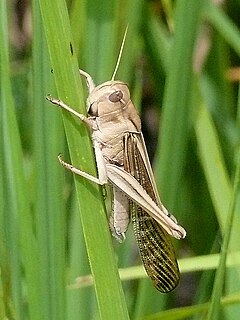 W
WLocusta migratoria migratorioides, commonly known as the African migratory locust, is a subspecies of the migratory locust in the family Acrididae.
 W
WAnacridium melanorhodon, known as the Sahelian tree locust, is a species of grasshoppers in the subfamily Cyrtacanthacridinae.
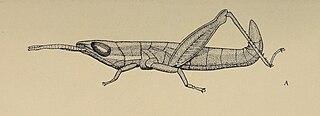 W
WBetiscoides is a small genus of southern African grasshoppers in the family Lentulidae.
 W
WBrachytrupes membranaceus, the tobacco cricket, is a species of cricket in the family Gryllidae. It is a pest of crops including young tobacco plants. There are four subspecies, all of which are native to Africa.
 W
WThe brown locust is a medium-sized small locust species in the monotypic genus Locustana. It is found in Southern Africa and shows classic gregarious behaviour with phase polymorphism on crowding.
 W
WCalephorus is the type genus of the Calephorini; a tribe of grasshoppers found in Africa, Europe and Indo-China.
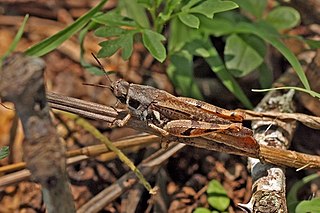 W
WCatantops is a genus of grasshoppers in the tribe Catantopini and is typical of the subfamily Catantopinae. Species can be found in Africa, including Madagascar and subcontinental India.
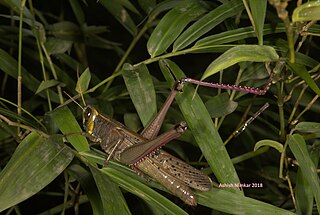 W
WChoroedocus is a genus of grasshoppers in the subfamily Catantopinae, not assigned to any tribe. Species can be found in South Africa, India and Indo-China.
 W
WChorthippus biguttulus, the bow-winged grasshopper, is one of the most common species of grasshopper found in the dry grassland of northern and central Europe. It is part of a group of species (biguttulus-group) that are very difficult to identify morphologically. Chorthippus biguttulus was previously classified as a single species Stauroderus variabilis. The three species were distinguished using song characteristics.
 W
WClonia is an African genus of bush crickets in the subfamily Saginae.
 W
WThe desert locust is a species of locust, a periodically swarming, short-horned grasshopper in the family Acrididae. They are found mainly in Africa, through Arabia and West Asia, and extending into parts of South Asia. During population surge years, they may extend into parts of western Spain. The desert locust shows periodic changes in its body form and can change, in response to environmental conditions, over generations, from a solitary, shorter-winged, highly fecund, nonmigratory form to a gregarious, long-winged, and migratory phase in which they may travel long distances into new areas. In some years, they may thus form locust plagues, invading new areas, where they may consume all vegetation including crops, and at other times, they may live unnoticed in small numbers.
 W
WDictyophorus griseus is a species of African grasshopper in the family Pyrgomorphidae, the gaudy grasshoppers.
 W
WDictyophorus spumans, the koppie foam grasshopper or rooibaadjie, is a species of grasshopper in the family Pyrgomorphidae indigenous to Africa. The name "foaming grasshopper" derives from the insect's ability to produce a toxic foam from its thoracic glands. It is closely related to Phymateus.
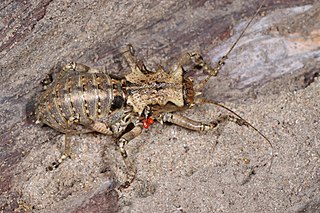 W
WEnyaliopsis is the largest genus in the subfamily Hetrodinae of the family Tettigoniidae. It is made up of 24 species found from east-central to southern Africa.
 W
WEuconocephalus is a genus of bush cricket in the 'conehead' tribe Copiphorini.
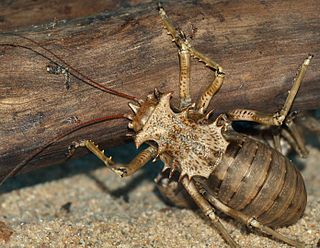 W
WEugaster spinulosa is a species of bush-cricket from Morocco.
 W
WEumodicogryllus is a genus of crickets in the family Gryllidae and tribe Modicogryllini. Species in this genus are similar to - and were originally considered a subgenus of - Modicogryllus (Eumodicogryllus); they have been recorded from: Europe, northern Africa and temperate Asia.
 W
WEyprepocnemis is a genus of grasshoppers in the subfamily Eyprepocnemidinae with species found in Africa, Southern Europe through to tropical Asia.
 W
WEyprepocnemis plorans, the lamenting grasshopper, is a species of insect in the family Acrididae. It is the type species of the genus Eyprepocnemis, and is found in Africa, parts of the Middle East, and southern Europe. It typically inhabits wetlands and other moist habitats.
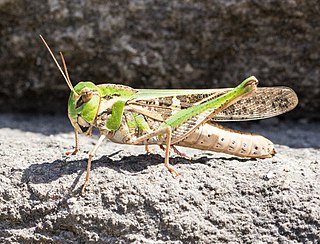 W
WGastrimargus is a genus of grasshoppers in the subfamily Oedipodinae. The recorded distribution of species in this genus includes Africa, Asia, and Oceania.
 W
WGryllodes is a genus of crickets in the family Gryllidae and tribe Gryllini. Species have been recorded in Australia, Asia, Africa (Ethiopia), central Europe, subtropical and tropical Americas.
 W
WGryllus is a genus of field cricket. Members of the genus are typically 15–31 mm long and darkly coloured. The type species is Gryllus campestris L.: the European field cricket.
 W
WHolochlora is a genus of bush-crickets in the subfamily Phaneropterinae. They occur in Africa and Asia.
 W
WHomoeogryllus orientalis, the South African bell cricket, is a species in the tribe Homoeogryllini of the subfamily Cachoplistinae. The species is reported from southern tropical Africa including parts of Mozambique and South Africa. Within South Africa it has been reported south of the tropics in the Bushveld and in the Orange Free State.
 W
WLentula is a small genus of grasshoppers native to southern Africa. It is the type genus of the family Lentulidae.
 W
WThe Lentulidae are a family of grasshoppers found in sub-Saharan Africa.
 W
WLeptophyes is a genus of bush-crickets found in Africa, Asia, and Europe. The genus was erected by Franz Xaver Fieber in 1853.
 W
WThe migratory locust is the most widespread locust species, and the only species in the genus Locusta. It occurs throughout Africa, Asia, Australia and New Zealand. It used to be common in Europe but has now become rare there. Because of the vast geographic area it occupies, which comprises many different ecological zones, numerous subspecies have been described. However, not all experts agree on the validity of some of these subspecies.
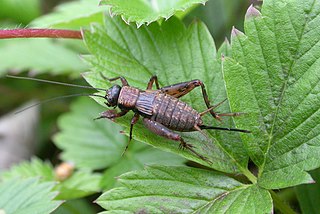 W
WNemobius sylvestris, the wood cricket, is a flightless species of cricket in the family Gryllidae. It is native to Western Europe and North Africa but uncommon in Britain.
 W
WNsenene is the Luganda name for Ruspolia differens: a bush cricket in the tribe Copiphorini of the 'cone-head' subfamily.
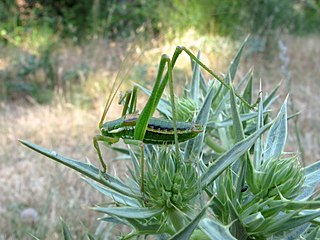 W
WOdontura is a genus of bush crickets in the subfamily Phaneropterinae and typical of the tribe Odonturini. Species can be found in Africa and Europe.
 W
WOecanthus is a genus of cricket in subfamily Oecanthinae, the tree crickets.
 W
WOrnithacris is a genus of grasshoppers in the subfamily Cyrtacanthacridinae. These are large insects, recognisable by their brightly coloured wings when caught: although they are difficult to catch being strong fliers. Species are found throughout Africa, south of the Sahara and may be moderately significant to minor agricultural pests.
 W
WThe Parktown prawn, African king cricket or tusked king cricket is a species of king cricket endemic to Southern Africa. It is unrelated to prawns, Libanasidus being insects in the order Orthoptera – crickets, locusts and similar insects. The king crickets are not true crickets either: they belong to the family Anostostomatidae, whereas true crickets are in the Gryllidae. The insect gets its English name from the suburb of Parktown in Johannesburg, South Africa, where they are common. It is found throughout Namibia, and in the southern savanna and semi-arid regions of Angola. The Parktown prawn is related to the New Zealand tree weta, which is also in the family Anostostomatidae.
 W
WPezotettix is a genus of 'short-horned grasshoppers' belonging to the family Acrididae subfamily Pezotettiginae.
 W
WPhaneroptera nana, common name southern sickle bush-cricket is a species in the family Tettigoniidae and subfamily Phaneropterinae. It has become an invasive species in California where it may be called the Mediterranean katydid.
 W
WPhymateus aegrotus, sometimes called the blue bush locust or East African bush locust, is a pest species of grasshopper in the family Pyrgomorphidae. Unlike "locusts" the adults are not known to change their morphology on crowding, but at the hopper stage, marching behaviour of small bands may occur.
 W
WPhymateus karschi is a locust in the family Pyrgomorphidae.
 W
WPhymateus viridipes, also known as the Green milkweed locust or African bush grasshopper, is an African locust in the family Pyrgomorphidae.
 W
WPseudorhynchus is an Asian genus of bush crickets in the tribe Copiphorini, belonging to the 'conehead' subfamily Conocephalinae.
 W
WRuspolia is a genus of bush crickets in the subfamily Conocephalinae. This genus includes species that may be called 'cone-heads', but the name has also been used for Conocephalus and other genera in the subfamily.
 W
WRuspolia nitidula is a species belonging to the subfamily Conocephalinae of the family Tettigoniidae. It is found throughout Europe, Africa, and the Palearctic part of Asia. A vernacular name that has been used is "cone-headed grasshopper", although it is not a grasshopper, but rather a bush cricket.
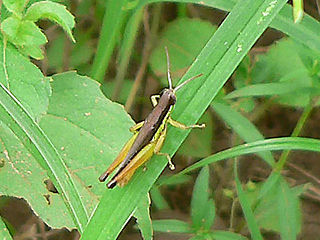 W
WSpathosterninae is a subfamily of grasshoppers, based on the genus Spathosternum. Within the monotypic tribe Spathosternini there are currently 3 genera and about 12 described species recorded from Africa, the Indian subcontinent, south-east Asia and north-east Australia.
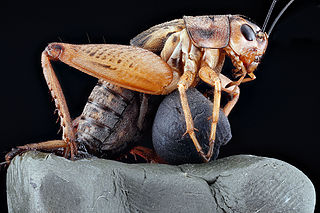 W
WVelarifictorus is a genus of crickets in the family Gryllidae and tribe Gryllini. Species have been recorded in Australia, Asia, Africa and the southeastern US.
 W
WZabalius is a genus of bush crickets or katydids in the subfamily Pseudophyllinae. Its distribution is essentially Afrotropical. They are generally heavily built, tree-dwelling herbivorous katydids, capable of flight.
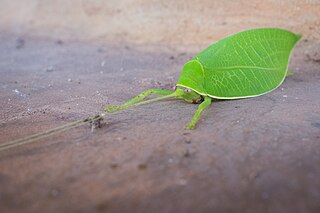 W
WThe Blue-legged Sylvan Katydid is a species of katydid, endemic to the South Africa region. IUCN classes it as Least concern due to its widespread distribution.